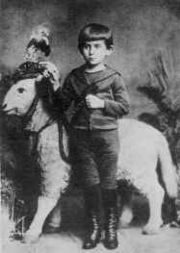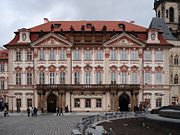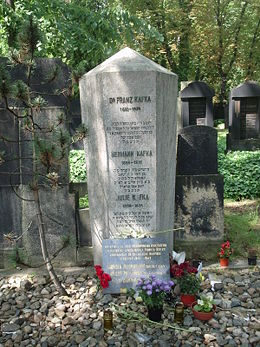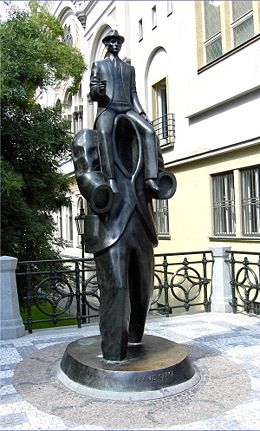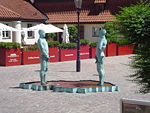Franz Kafka
2008/9 Schools Wikipedia Selection. Related subjects: Writers and critics
| Franz Kafka | |
|---|---|
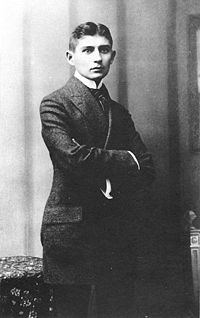 Photograph of Franz Kafka taken in 1906 |
|
| Born | July 3, 1883 Prague, Austria-Hungary |
| Died | June 3, 1924 (aged 40) Kierling near Vienna, Austria |
| Occupation | insurance officer, factory manager, novelist, short story writer |
| Nationality | Jewish- Bohemian (Austria-Hungary) |
| Genres | novel, short story |
| Literary movement | modernism, existentialism, precursor to magical realism |
| Notable work(s) | The Trial, The Castle, The Metamorphosis |
|
Influences
|
|
|
Influenced
|
|
| Signature | |
Franz Kafka (IPA: [ˈfʀanʦ ˈkafka]) ( 3 July 1883 - 3 June 1924) was one of the major German-language fiction writers of the 20th century. He was born to a middle-class Jewish family in Prague, Austria-Hungary (now Czech Republic). His unique body of writing—much of which is incomplete and was mainly published posthumously—is among the most influential in Western literature.
His stories, such as The Metamorphosis (1915), and novels, including The Trial (1925) and The Castle (1926), concern troubled individuals in a nightmarishly impersonal and bureaucratic world.
Family
Kafka was born into a middle-class, German-speaking Jewish family in Prague, the capital of Bohemia. His father, Hermann Kafka (1852–1931), was described as a "huge, selfish, overbearing businessman" and by Kafka himself as "a true Kafka in strength, health, appetite, loudness of voice, eloquence, self-satisfaction, worldly dominance, endurance, presence of mind, [and] knowledge of human nature". Hermann was the fourth child of Jacob Kafka, a ritual slaughterer, and came to Prague from Osek, a Czech-speaking Jewish village near Písek in southern Bohemia. After working as a traveling sales representative, he established himself as an independent retailer of men's and women's fancy goods and accessories, employing up to 15 people and using a jackdaw (kavka in Czech) as his business logo. Kafka's mother, Julie (1856—1934), was the daughter of Jakob Löwy, a prosperous brewer in Poděbrady, and was better educated than her husband.
Kafka was the eldest of six children. He had two younger brothers, Georg and Heinrich, who died at the ages of fifteen months and six months, respectively, before Kafka was seven, and three younger sisters, Gabriele ("Elli") (1889–1941), Valerie ("Valli") (1890–1942), and Ottilie ("Ottla") (1891–1943). On business days, both parents were absent from the home. His mother helped to manage her husband's business and worked in it as much as 12 hours a day. The children were largely reared by a series of governesses and servants.
Kafka's sisters were sent with their families to the Łódź Ghetto and died there or in concentration camps. Ottla was sent to the concentration camp at Theresienstadt and then on October 7, 1943 to the death camp at Auschwitz, where 1267 children and 51 guardians, including Ottla, were gassed to death on their arrival.
Education
Kafka learned German as his first language, but he was also fluent in Czech. Later, Kafka acquired some knowledge of French language and culture; one of his favorite authors was Flaubert. From 1889 to 1893, he attended the Deutsche Knabenschule, the boys' elementary school at the Masný trh/Fleischmarkt (meat market), the street now known as Masná street. His Jewish education was limited to his Bar Mitzvah celebration at 13 and going to the synagogue four times a year with his father. After elementary school, he was admitted to the rigorous classics-oriented state gymnasium, Altstädter Deutsches Gymnasium, an academic secondary school with eight grade levels, where German was also the language of instruction, at Old Town Square, within the Kinsky Palace. He completed his Maturita exams in 1901.
Admitted to the German Charles-Ferdinand University of Prague, Kafka first studied chemistry, but switched after two weeks to law. This offered a range of career possibilities, which pleased his father, and required a longer course of study that gave Kafka time to take classes in German studies and art history. At the university, he joined a student club, named Lese- und Redehalle der Deutschen Studenten, which organized literary events, readings and other activities. In the end of his first year of studies, he met Max Brod, who would become a close friend of his throughout his life, together with the journalist Felix Weltsch, who also studied law. Kafka obtained the degree of Doctor of Law on June 18, 1906 and performed an obligatory year of unpaid service as law clerk for the civil and criminal courts.
Work
On November 1, 1907, he was hired at the Assicurazioni Generali, a huge Italian insurance company, where he worked for nearly a year. His correspondence, during that period, witnesses that he was unhappy with his working time schedule - from 8 p.m. (20:00) until 6 a.m. (06:00) - as it made it extremely difficult for him to concentrate on his writing. On July 15, 1908, he resigned, and two weeks later found more congenial employment with the Worker's Accident Insurance Institute for the Kingdom of Bohemia. His father often referred to his son's job as insurance officer as a "Brotberuf", literally "bread job", a job done only to pay the bills. However, he did not show any signs of indifference towards his job, as the several promotions that he received during his career suggest that he was a hardworking employee. The contention, made by Peter Drucker in Managing in the Next Society, that Kafka invented the first civilian hard hat and received a medal for this invention in 1912 because it reduced Bohemian steel mill deaths to fewer than 25 per thousand employees, is not supported by any document from his employer's archives. He was also given the task of compiling and composing the annual report and was reportedly quite proud of the results, sending copies to friends and family. In parallel, Kafka was also committed to his literary work. Together with his close friends Max Brod and Felix Weltsch, these three were called "Der enge Prager Kreis", the close Prague circle, which was part of a broader Prague Circle, "a loosely knit group of German-Jewish writers who contributed to the culturally fertile soil of Prague during the 1880s until after World War I."
In 1911, Karl Hermann, spouse of his sister Elli, proposed Kafka collaborate in the operation of an asbestos factory known as Prager Asbestwerke Hermann and Co. Kafka showed a positive attitude at first, dedicating much of his free time to the business. During that period, he also found interest and entertainment in the performances of Yiddish theatre, despite the misgivings of even close friends such as Max Brod, who usually supported him in everything else. Those performances also served as a starting point for his growing relationship with Judaism.
Later years
In 1912, at Max Brod's home, Kafka met Felice Bauer, who lived in Berlin and worked as a representative for a dictaphone company. Over the next five years they corresponded a great deal, met occasionally, and twice were engaged to be married. Their relationship finally ended in 1917.
In 1917, Kafka began to suffer from tuberculosis, which would require frequent convalescence during which he was supported by his family, most notably his sister Ottla. Despite his fear of being perceived as both physically and mentally repulsive, he impressed others with his boyish, neat, and austere good looks, a quiet and cool demeanor, obvious intelligence and dry sense of humor.
In 1921 he developed an intense relationship with Czech journalist and writer Milena Jesenská. In July 1923, throughout a vacation to Graal-Müritz on the Baltic Sea, he met Dora Diamant and briefly moved to Berlin in the hope of distancing himself from his family's influence to concentrate on his writing. In Berlin, he lived with Dora Diamant, a 25-year-old kindergarten teacher from an orthodox Jewish family, who was independent enough to have escaped her past in the ghetto. Dora became his lover, and influenced Kafka's interest in the Talmud.
It is generally agreed that Kafka suffered from clinical depression and social anxiety throughout his entire life. He also suffered from migraines, insomnia, constipation, boils, and other ailments, all usually brought on by excessive stresses and strains. He attempted to counteract all of this by a regimen of naturopathic treatments, such as a vegetarian diet and the consumption of large quantities of unpasteurized milk. However, Kafka's tuberculosis worsened; he returned to Prague, then went to Dr. Hoffmann's sanatorium in Kierling near Vienna for treatment, where he died on June 3, 1924, apparently from starvation. The condition of Kafka's throat made eating too painful for him, and since parenteral nutrition had not yet been developed, there was no way to feed him (a fate resembling that of Gregor in the Metamorphosis and the main character of A Hunger Artist). His body was ultimately brought back to Prague where he was interred on June 11, 1924, in the New Jewish Cemetery (sector 21, row 14, plot 33) in Prague-Žižkov.
Personal views
Kafka was not formally involved in Jewish religious life, but he showed a great interest in Jewish culture and spirituality. He was deeply fascinated by the Jews of Eastern Europe who he regarded as having an intensity of spiritual life Western Jews did not have. Yet he was at times alienated from Judaism and Jewish life: "What have I in common with Jews? I have hardly anything in common with myself and should stand very quietly in a corner, content that I can breathe."
During the later years of his life, Kafka developed an interest in moving to Mandate Palestine. He dreamed of going with Dora Diamant to create a new kind of life in the Land of Israel. Here too he was perhaps influenced by his Zionist friends Hugo Bergmann and Max Brod. Tragically, Kafka's tuberculosis was too advanced and he was unable to realize this dream of his final years.
Literary work
Kafka published only a few short stories during his lifetime, a small part of his work, and never finished any of his novels (with the possible exception of The Metamorphosis, which some consider to be a short novel). His writing attracted little attention until after his death. Prior to his death, he instructed his friend and literary executor Max Brod to destroy all of his manuscripts. His lover, Dora Diamant, partially executed his wishes, secretly keeping up to 20 notebooks and 35 letters until they were confiscated by the Gestapo in 1933. An ongoing international search is being conducted for these missing Kafka papers. Brod overrode Kafka's instructions and instead oversaw the publication of most of the work in his possession, which soon began to attract attention and high critical regard.
All of Kafka's published works, except several letters he wrote in Czech to Milena Jesenská, were written in German.
Style of writing
Kafka often made extensive use of a trait special to the German language allowing for long sentences that sometimes can span an entire page. Kafka's sentences then deliver an unexpected impact just before the full stop - that being the finalizing meaning and focus. This is achieved due to the construction of certain sentences in German which require that the verb be positioned at the end of the sentence. Such constructions cannot be duplicated in English, so it is up to the translator to provide the reader with the same effect found in the original text. One such instance of a Kafka translator's quandary is demonstrated in the first sentence of The Metamorphosis.
Another virtually insurmountable problem facing the translator is how to deal with the author's intentional use of ambiguous terms or of words that have several meanings. An example is Kafka's use of the German noun Verkehr in the final sentence of The Judgment. Literally, Verkehr means intercourse and, as in English, can have either a sexual or non-sexual meaning; in addition, it is used to mean transport or traffic. The sentence can be translated as: "At that moment an unending stream of traffic crossed over the bridge." What gives added weight to the obvious double meaning of 'Verkehr' is Kafka's confession to his friend and biographer Max Brod that when he wrote that final line, he was thinking of "a violent ejaculation." In the English translation, of course, what can 'Verkehr' be but "traffic?"
Critical interpretation
Critics have interpreted Kafka's works in the context of a variety of literary schools, such as modernism, magical realism, and so on. The apparent hopelessness and absurdity that seem to permeate his works are considered emblematic of existentialism. Others have tried to locate a Marxist influence in his satirization of bureaucracy in pieces such as In the Penal Colony, The Trial, and The Castle, whereas others point to anarchism as an inspiration for Kafka's anti-bureaucratic viewpoint. Still others have interpreted his works through the lens of Judaism (Borges made a few perceptive remarks in this regard), through Freudianism (because of his familial struggles), or as allegories of a metaphysical quest for God ( Thomas Mann was a proponent of this theory).
Themes of alienation and persecution are repeatedly emphasized, and the emphasis on this quality, notably in the work of Marthe Robert, partly inspired the counter-criticism of Gilles Deleuze and Felix Guattari, who argued that there was much more to Kafka than the stereotype of a lonely figure writing out of anguish, and that his work was more deliberate, subversive, and more "joyful" than it appears to be.
Furthermore, an isolated reading of Kafka's work — focusing on the futility of his characters' struggling without the influence of any studies on Kafka's life was worthless — reveals the humor of Kafka. Kafka's work, in this sense, is not a written reflection of any of his own struggles, but a reflection of how people invent struggles.
Biographers have said that it was common for Kafka to read chapters of the books he was working on to his closest friends, and that those readings usually concentrated on the humorous side of his prose. Milan Kundera refers to the essentially surrealist humour of Kafka as a main predecessor of later artists such as Federico Fellini, Gabriel García Márquez, Carlos Fuentes and Salman Rushdie. For García Márquez, it was as he said the reading of Kafka's The Metamorphosis that showed him "that it was possible to write in a different way".
Publications and dates
Much of Kafka's work was unfinished, or prepared for publication posthumously by Max Brod. The novels The Castle (which stopped mid-sentence and had ambiguity on content), The Trial (chapters were unnumbered and some were incomplete) and Amerika (Kafka's original title was The Man who Disappeared) were all prepared for publication by Brod. It appears Brod took a few liberties with the manuscript (moving chapters, changing the German and cleaning up the punctuation), and thus the original German text was altered prior to publication. The editions by Brod are generally referred to as the Definitive Editions.
According to the publisher's note for The Castle, Malcolm Pasley was able to get most of Kafka's original handwritten work into the Oxford Bodleian Library in 1961. The text for The Trial was later acquired through auction and is stored at the German literary archives at Marbach, Germany.
Subsequently, Pasley headed a team (including Gerhard Neumann, Jost Schillemeit, and Jürgen Born) in reconstructing the German novels and S. Fischer Verlag republished them. Pasley was the editor for Das Schloß (The Castle), published in 1982, and Der Prozeß (The Trial), published in 1990. Jost Schillemeit was the editor of Der Verschollene ( Amerika) published in 1983. These are all called the 'Critical Editions' or the 'Fischer Editions'. The German critical text of these, and Kafka's other works, may be found online at The Kafka Project.
There is another Kafka Project based at San Diego State University, which began in 1998 as the official international search for Kafka's last writings. Consisting of 20 notebooks and 35 letters to Kafka's last companion, Dora Diamant (later, Dymant-Lask), this missing literary treasure was confiscated from her by the Gestapo in Berlin 1933. The Kafka Project's four-month search of government archives in Berlin in 1998 uncovered the confiscation order and other significant documents. In 2003, the Kafka Project discovered three original Kafka letters, written in 1923. Building on the search conducted by Max Brod and Klaus Wagenbach in the mid-1950s, the Kafka Project at SDSU has an advisory committee of international scholars and researchers, and is calling for volunteers who want to help solve a literary mystery. In 2008, academic and Kafka expert James Hawes accused scholars of suppressing details of the pornography hidden in Kafka's journals to preserve the writer's image.
Translations
There are two primary sources for the translations based on the two German editions. The earliest English translations were by Edwin and Willa Muir and published by Alfred A. Knopf. These editions were widely published and spurred the late-1940's surge in Kafka's popularity in the United States. Later editions (notably the 1954 editions) had the addition of the deleted text translated by Eithne Wilkins and Ernst Kaiser. These are known 'Definitive Editions'. They translated both The Trial, Definitive and The Castle, Definitive among other writings. Definitive Editions are generally accepted to have a number of biases and to be dated in interpretation.
After Pasley and Schillemeit completed their recompilation of the German text, the new translations were completed and published -- The Castle, Critical by Mark Harman ( Schocken Books, 1998), The Trial, Critical by Breon Mitchell ( Schocken Books, 1998) and Amerika: The Man Who Disappeared by Michael Hoffman ( New Directions Publishing, 2004). These editions are often noted as being based on the restored text.
Legacy
Franz Kafka has a museum dedicated to his work in Prague, Czech Republic. The term " Kafkaesque" is widely used to describe concepts, situations, and ideas which are reminiscent of Kafka's works, particularly The Trial and "The Metamorphosis".
In Mexico, the phrase "Si Franz Kafka fuera mexicano, sería costumbrista" (If Franz Kafka were Mexican, he would be a Costumbrista writer) is commonly used in newspapers, blogs, and online forums to tell how hopeless and absurd the situation in the country is.
It has been noted that "from the Czech point of view, Kafka was German, and from the German point of view he was, above all, Jewish" and that this was a common "fate of much of Western Jewry."
Kafka in literature
- Nobel Prize winner Isaac Bashevis Singer wrote a short story called "A Friend of Kafka," which was about a Yiddish actor called Jacques Kohn who said he knew Franz Kafka. In this story, according to Jacques Kohn, Kafka believed in the Golem, a legendary creature from Jewish folklore.
- Kafka Americana by Jonathan Lethem and Carter Scholz is a collection of stories based on Kafka's life and works.
- Kafka on the Shore by Haruki Murakami
- Kafka was the Rage, a Greenwich Village Memoir by Anatole Broyard
- Kafka's Curse by Achmat Dangor
- The Kafka Effekt by American bizarro author D. Harlan Wilson, who relates his take on the irrealism genre of literature to that of Franz Kafka, and to that of William S. Burroughs.
Film
For a full list of films The IMDb filmography
Kafka's Life
- Kafka (1990) Jeremy Irons stars as the eponymous author. Written by Lem Dobbs and directed by Steven Soderbergh, the movie mixes his life and fiction providing a semi-biographical presentation of Kafka's life and works. The story concerns Kafka investigating the disappearance of one of his work colleagues. The plot takes Kafka through many of the writer's own works, most notably The Castle and The Trial.
- Franz Kafka (1992) at the Internet Movie Database : an animated film by Piotr Dumała
Novels
- The Trial (1962) Orson Welles wrote and directed this adaptation of the novel starring Anthony Perkins. In a 1962 BBC Interview with Huw Wheldon, Orson Welles noted, "Say what you like, but The Trial is the best film I have ever made".
- Klassenverhältnisse Class Relations (1984) Directed by the experimental filmmaking duo of Jean-Marie Straub and Danièle Huillet based on Kafka's novel Amerika.
- The Trial (1993) Starring Kyle MacLachlan as Joseph K. with Anthony Hopkins in a cameo role as the priest as a strictly faithful adaptation with a screenplay by playwright Harold Pinter.
- Das Schloß (1997) at the Internet Movie Database by Michael Haneke
Metamorphosis
- Die Verwandlung (1975) at the Internet Movie Database
- Förvandlingen (1976/I) at the Internet Movie Database
- The Metamorphosis of Mr. Samsa (1977) at the Internet Movie Database : an animated short by Caroline Leaf
- Metamorphosis (1987) at the Internet Movie Database
- Franz Kafka's 'It's a Wonderful Life' (1993) is an Oscar-winning short film written and directed by Peter Capaldi and starring Richard E. Grant as Kafka. The film blends " Metamorphosis" with Frank Capra's It's a Wonderful Life.
- The Metamorphosis of Franz Kafka (1993) by Carlos Atanes, at YouTube.
- Prevrashcheniye (2002) at the Internet Movie Database
- Metamorfosis (2004) at the Internet Movie Database
Short stories
- Zoetrope : an experimental avant-garde short film by Charlie Deaux, Zoetrope (1999) at the Internet Movie Database. Adaptation of "In the Penal Colony".
- The Hunger Artist (2002) at the Internet Movie Database : an animated feature by Tom Gibbons
- Menschenkörper (2004) at the Internet Movie Database Adaptation of "A Country Doctor".
Theatre
- Alan Bennett, Kafka's Dick, 1986, a play in which the ghosts of Kafka, his father Hermann, and Max Brod arrive at the home of an English insurance clerk (and Kafka aficionado) and his wife.
- Milan Richter, Kafka's Hell-Paradise, 2006, a play with 5 characters, using Kafka's aphorisms, dreams and re-telling his relations to his father and to the women. Translated from the Slovak by Ewald Osers.
- Milan Richter, Kafka's Second Life, 2007, a play with 17 characters, starting in Kierling where Kafka is dying and ending in Prague in 1961. Translated from the Slovak by Ewald Osers.
- Tadeusz Różewicz, Pułapka (The Trap), 1982, a play loosely based on Kafka's diaries and letters
